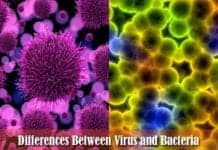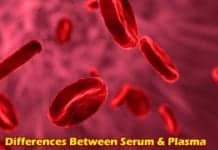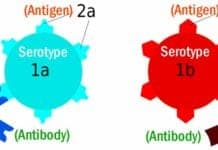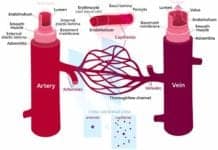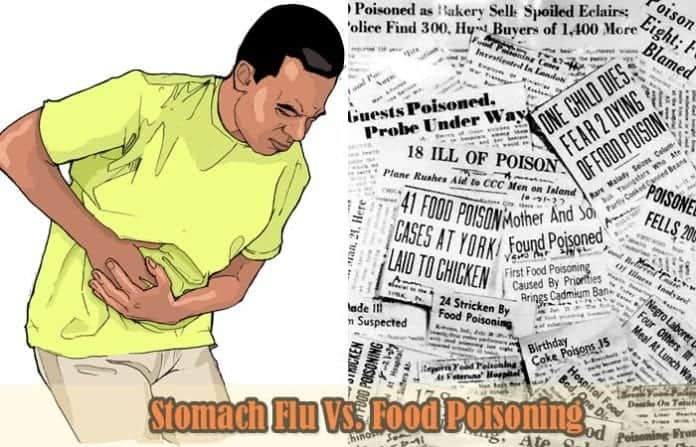
Stomach Flu Vs Food Poisoning: Food safety is an important issue worldwide. Food that has been adulterated or contaminated with a chemical substance, or microorganism or toxin can cause food-borne illnesses. Food contamination could be either physical, chemical, or biological.
Physical contamination refers to food contamination by physical foreign objects such as plastic, steel wool, etc. It usually occurs during the production or packaging process. There is a risk of physical contamination being accompanied by a microorganism causing biological contamination.
Chemical contamination involves contamination with a chemical substance. One of the most common chemical contaminants are pesticides, which can cause illnesses or result in a fatality.
Biological contamination refers to contamination of food with microorganisms or their toxins that can lead to illnesses such as gastroenteritis or food poisoning.
Microorganisms that are usual contaminants of food include bacteria, viruses, parasites or fungi. Refer to how are viruses are different from bacteria page for a detailed discussion.
Food-borne illnesses are a common occurrence worldwide. One such condition, termed as gastroenteritis is particularly common. It is also known as “stomach flu“. The term stomach flu indicates that this condition is typical, caused by a virus, although unrelated to the influenza group of viruses. Another condition that is also common, but can be caused by other microorganisms as well, apart from viruses is food-poisoning.
Food-poisoning occurs due to ingestion of food contaminated with a virus, bacteria, or a parasite. Both these conditions have similar symptoms. However, certain differences can be elucidated between the two regarding cause, severity, treatment, transmission, and so on.
Let’s explore all differences between stomach flu and food poisoning from all aspects below.
Table of Contents
What is Stomach Flu?
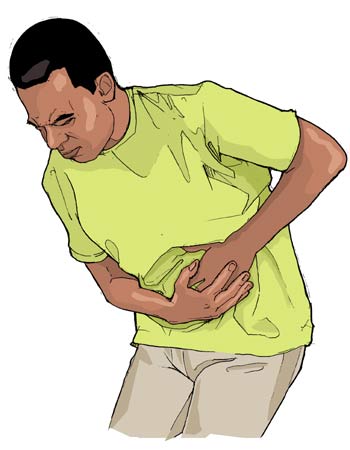
Medically known as gastroenteritis, the term stomach flu encompasses a host of different inflammatory conditions that affect the gastrointestinal system.
- The lining of the stomach and intestines are found to be inflamed in gastroenteritis, which is caused by a bacterial, viral or parasitic pathogen. Most commonly gastroenteritis is caused by the norovirus (in adults) and rotavirus (in children). The condition is easily transmissible through close contact with an infected person or through inappropriately prepared food or contaminated water.
- Globally, the disease is common; however, 2015 statistics show that over 2 billion cases of stomach flu occurred which resulted in 1.3 million deaths, most commonly in the developing countries which have limited access to good healthcare facilities.
![]()
What is Food Poisoning?
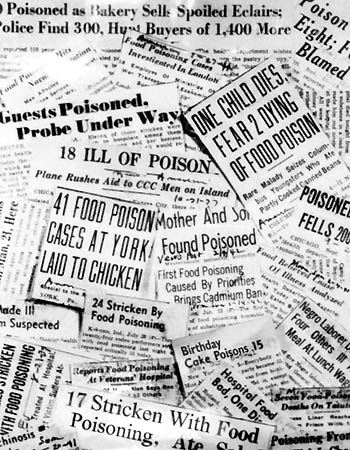
Food poisoning is a food-borne illness that occurs due to ingestion of contaminated or infected food. It is typically caused by any pathogen – virus, bacteria or parasitic, or their toxins.
- The contamination can occur at any point of processing or packaging of food or food products. Contaminants can also be introduced by improper handling or improper cooking techniques, such as undercooked meat, seafood or poultry.
- The onset of this illness occurs within hours of ingestion of contaminated food and can last until a few days.
![]()
Differences between Stomach Flu and Food Poisoning
Both stomach flu and food poisoning are food-borne illnesses that have discernable differences between them. The following table elucidates these differences.
| Aspect | Stomach Flu | Food Poisoning |
|---|---|---|
| Cause | Caused typically by a virus: Rotavirus – generally affects infants and children; adenovirus, calicivirus, specifically norovirus, affects both adults and children. Astrovirus affects adults and is more prevalent in the winter months. | It can be caused either by a virus, parasite, fungus or bacteria. Bacterial pathogens include:
E.coli – A particular strain of E-coli known as 0157: H7 is responsible for Food poisoning and is usually found in contaminated meat and poultry and contaminated water. Campylobacter – It is the most common cause of food poisoning in adults and is found in undercooked meat and poultry, unpasteurized milk and contaminated water. Shigella is commonly found in stool and is easily transmissible between people, particularly between daycare and school going kids. Clostridium botulinum, a bacteria that contaminated canned and processed food. This illness is caused by the botulinum toxin produced by this bacterium. Listeria monocytogenes, a bacterium commonly found in soil, and contaminated water is also a causative agent of food poisoning. Staphylococcus aureus, a bacterium typically associated with respiratory illnesses, can also cause food-borne illnesses like food-poisoning. It is commonly transmitted through sneezing or coughing and is airborne. Parasites, also uncommon, can also cause stomach flu or gastroenteritis. Contaminated drinking water can transmit organisms such as giardia and cryptosporidium. Protozoans such as Entamoeba are known to cause amoebiasis, a form of gastrointestinal infection, usually caused by contaminated drinking water. |
| Incubation period | 1-2 days (24-48 hours) after exposure to the virus, depending on the strain. | Quicker than the stomach flu. 2-6 hours after exposure to the pathogen. |
| Duration | Between 1-12 days depending on the viral strain. | About 1-3 days depending on the pathogen and treatment intervention. |
| Symptoms | Diarrhea, constipation, fever, vomiting, nausea, intestinal cramps, weight loss, and joint stiffness. | Diarrhea, fever, fatigue, feeling unwell, muscle aches or body pain, headaches, sweating, feeling thirsty, nausea, and vomiting. |
| Diagnosis | Diagnosis usually is made based on the symptoms presented. A stool test may sometimes be required to rule out other pathogenic causative organisms. | Diagnosis of food-poisoning involves taking a detailed history of what the infected individual ingested, and when symptoms began. A physical examination as well as a blood or stool test may be needed. |
| Treatment | Does not require treatment and resolves on its own. However, oral rehydration salts are required and treatment of symptoms by prescribing anti-emetics for vomiting and Antidiarrheals for diarrhea. | Antibiotics for a bacterial infection, or anti-parasitics if the causative organism is a parasite. Oral rehydration salts and treatment of symptoms by prescribing anti-emetics for vomiting and antidiarrheals for diarrhea. |
| Prevention | Gastroenteritis can be prevented by maintaining proper hygiene conditions while cooking and eating. By washing hands before eating, cooking or other activities can significantly reduce the risk of food-borne illness. It is important to establish that ensuring cooking of meat, poultry, and seafood appropriately kill any bacterial, viral or parasitic pathogen. | Ensure food preparation area and cooking utensils are clean. It is important to ensure that meat, poultry and seafood are cooked well before eating, as cooking on high heat eliminates pathogens from the food. Milk and dairy products and other packaged products should be checked for expiry and used with caution. It is primarily important to wash hands before handling food whether cooking or eating and maintain general hygiene. |
| Transmission | From person to person through contact or infected surfaces. | From eating contaminated food or drinking contaminated water. |
| Complications severity | Symptoms are usually mild to moderate and tend to resolve on their own with proper management. Dehydration is a major complication which can occur when fluids and electrolytes lost through vomiting and diarrhea are not replaced by increased intake of water, fluids, and oral rehydration salts. | Symptoms in the case of food-poisoning can become severe if not treated promptly. Dehydration is a complication of food poisoning. |
As with any foodborne illness, preventive measures are of paramount importance in ceasing their onset and spread. It is important to maintain hygienic living conditions and ensure children are taught the same at home and school. Kitchen and food preparatory areas, cutlery and utensils need to be sterilized and cleaned well before use.
An important aspect of food-borne illnesses is its close affiliation with the food industry. Food packaging and processing companies need to follow stringent protocols and strict laws to ensure food safety and render food and water fit and safe for consumption. Meat, seafood, and poultry processing areas should exercise extreme caution in their processes.
Food distribution centers like supermarkets need to ensure their shelf products are authentic and are long-life, expiry dates need to be assessed and a regular inventory check performed. To keep food-illnesses at bay, it is important these measures need to be followed.
![]()
Cite This Page
References
- “What is Food Contamination?”. Accessed June 07, 2018. Link.
- “Stomach Flu Symptoms, Signs, Treat, How Long It Lasts & Contagious”. Accessed June 07, 2018. Link.
- “Food poisoning – Symptoms and causes – Mayo Clinic”. Accessed June 07, 2018. Link.
- “Stomach Bug or Food Poisoning: Learn the Differences”. Accessed June 07, 2018. Link.
- “Gastroenteritis (Stomach Flu): Symptoms, Causes, Treatments”. Accessed June 07, 2018. Link.
- “Gastroenteritis | healthdirect”. Accessed June 07, 2018. Link.




